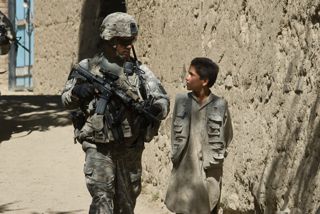Loading your audio article
JALREZ VALLEY, Afghanistan -- It's a chilly summer night in the Jalrez valley, lit well by a three-quarter moon. I'm on a mission with the men of the 4/25 Artillery Battalion, part of the 3rd Brigade Combat Team of the 10th Mountain Division, based in the Wardak and Logar provinces. We are weaving through ancient irrigation canals and wading across the numerous small rivers that feed the fertile valley, making our way to a medium sized village nestled into a hillside. Our winding path has been carefully chosen to minimize the chance that we will step on an IED, but it also seems to maximize the chance that everyone's feet will be completely soaked by the end of the operation.
The men of 4/25 are almost all "13 Bravos," the U.S. Army's designation for heavy artillery -- but there won't be any artillery fire tonight. In fact, their "tubes" are all packed away in storage, and have been since the 10th Mountain's arrival in Afghanistan eight months ago at the head of the "Afghanistan surge." What these artillery soldiers are doing here, on a dismounted infantry patrol through one of Afghanistan's most IED-laden provinces, illustrates the flexibility and patience that this new breed of warfare demands.
This fact isn't lost on the men in 4/25. They are quick to remind me that Napoleon called artillery the "king of the battlefield" and they bemoan the lack of artillery in these COIN operations. "I've seen guys in training put consecutive 155mm rounds through a window" boasts Sgt. First Class Ernest Steih. Yet the restrictive rules of engagement, coupled with an elusive enemy has prevented them from using their cannons in the fight -- and it's beginning to take a toll on their morale. The company I am embedded with has just lost four men in an IED attack, and like many attacks in this area, there was nobody around to shoot back at.

